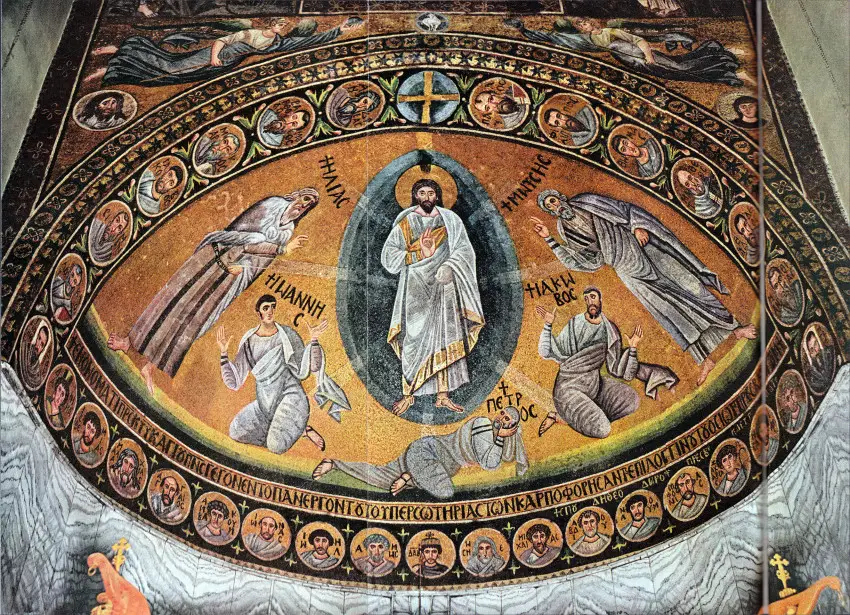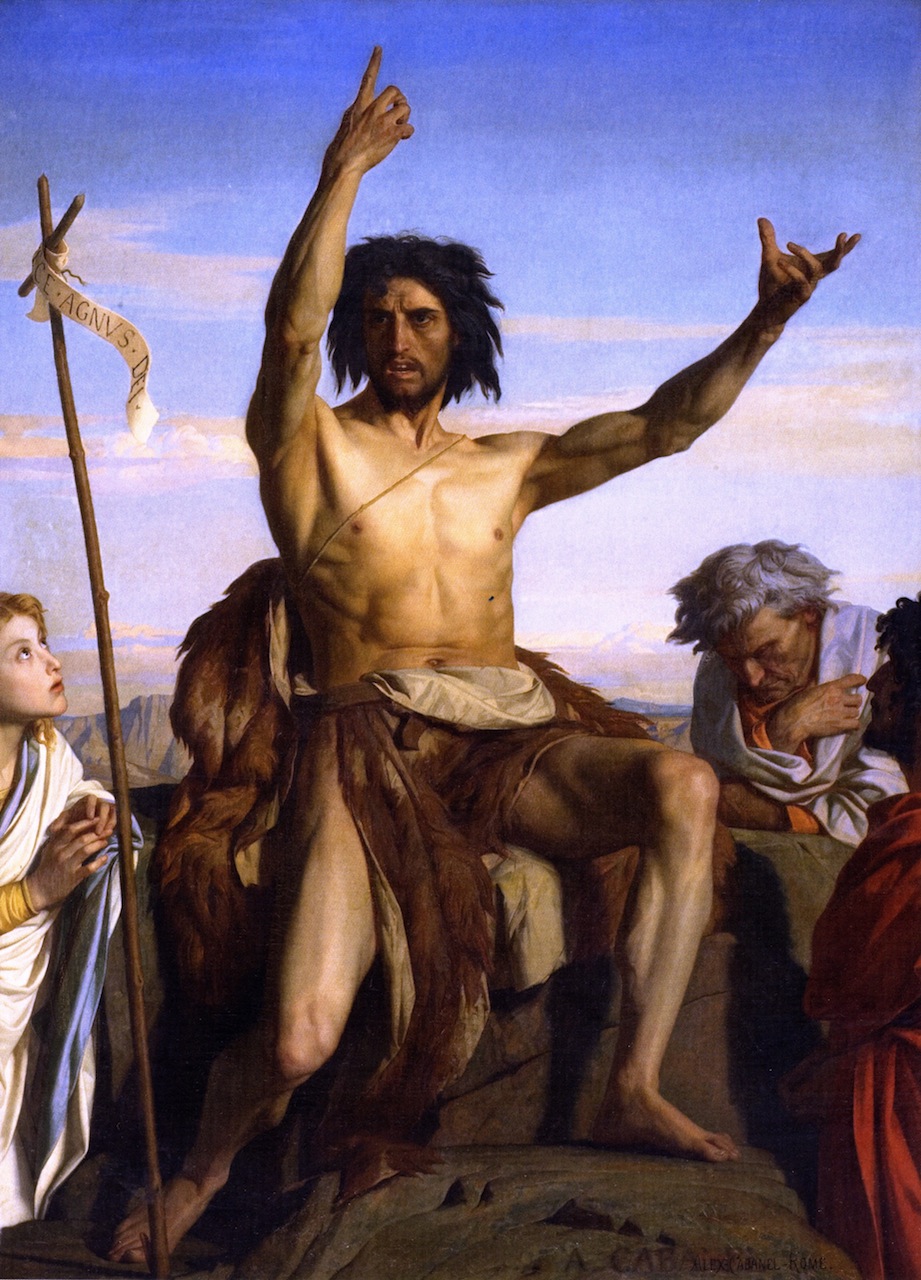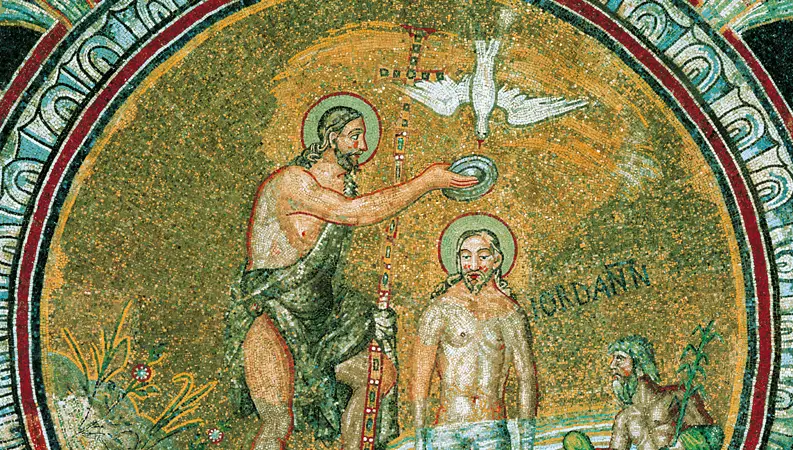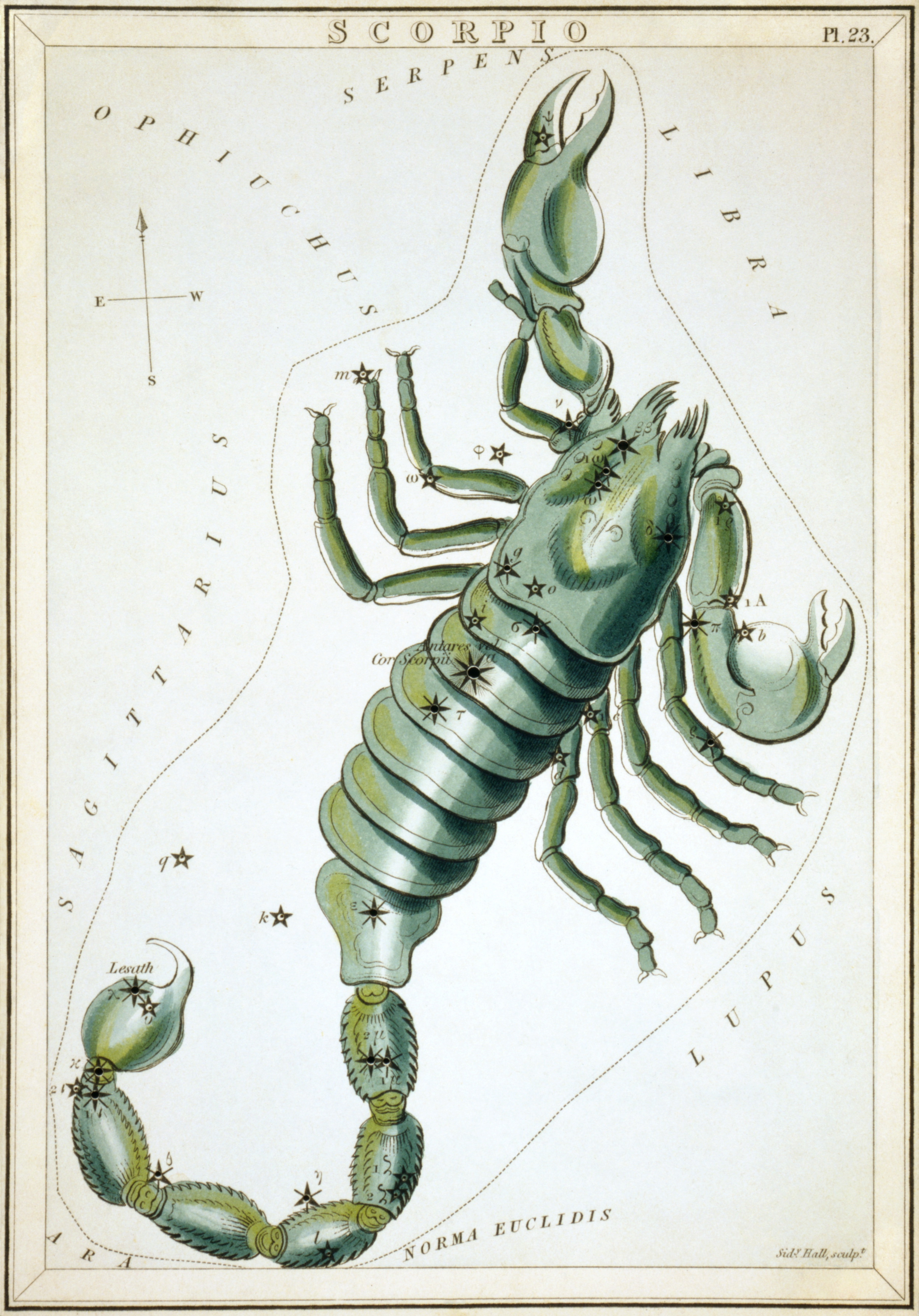di Andrew Casella
cover: “The creation of the Sun, the Moon and the stars”, ca. 1250-1260
The cycle of articles dedicated to sacred astronomy by Andrea Casella continues. In this appointment and in the one that will follow, the author focuses on the soteriology of the Christian Gospels, identifying the references — most of the time now forgotten and therefore misunderstood — to the ancient astroteological tradition. In this first part we will analyze in a special way the figure of John the Baptist and his relationship with Jesus (especially as regards "baptism") and that of Judas the Iscariot, connected with the constellation of Scorpio.
Although René Guénon and his followers completely reject the interpretations of myths and mythologists on an astronomical basis, in favor of (absolutely questionable) theoretical approaches on a metaphysical basis, and therefore purely literary and unscientific, as we have, even with all the limits If we try to do so, we cannot continue to ignore, at this point in the discourse, that astronomy (better, with the traditional term, astrology) constitutes the heart and raison d'être of mythological stories.
Indeed, the rejection of interpretation on an astrological basis as pointed out by some, is due to nothing other than a reading difficulty. The deciphering of mythical language (often completely absurd and baroque) meets the obvious obstacle of ignorance of the specific sector: in this case the knowledge of astronomy. When one is wholly or nearly totally lacking in specific knowledge, how can one expect that one is committed to a correct interpretation? This problem is well highlighted by Giorgio de Santillana. He says, not without a vein of controversy, the great scholar [1]:
« When will there come, we ask, that glorious day when philologists will begin to realize that 'sacrifices' and 'victims' chained to a 'sacrificial stake' or a mountain have a purely cosmological meaning? "
On the other hand, scholars from other sectors of knowledge cannot be blamed either: as always happens, one cannot know everything, but the contributions they make should be kept for what they are, i.e. hypotheses endowed with dignity equal to that of all the others, without claiming exclusivity in their absolute truth. And scholars (in this case metaphysicians, and therefore proponents of a strictly anagogical interpretation of myths) such as Guénon, should have learned this lesson, before liquidating Volney and Dupuis with a laconic sentence.
It is certainly true that myths almost always refer to other meanings (the language of myth it cannot be otherwise), but the metaphysical, and indeed, I would dare to say, theological interpretation of them is almost certainly the result of a fundamental error. Doubt is an obligation, uncertainty is the engine of the search for truth. It is no coincidence that a great sarcastic late antiquity like Luciano of Samosata had suspected that behind the Boccaccio story of the network of Hephaestus, narrated by Homer inIliad, an astronomical meaning was actually hidden, consisting of an alignment between planets, in this case Venus and Mars, in the "network" of the Pleiades. Only the detached observation of the phenomena can allow a calm and cold analysis, and therefore, almost certainly, correct.
The myth of Dionysus-Zagreo, with its singular events of tearing and reduction ad unum, has been interpreted (certainly on the basis of the ancient commentators) as a metaphor of the individual soul dispersed in matter (the Titans) which needs to be brought back to unity, that is, to merge again in the soul of the original world. This interpretation, poetic and metaphysical at the same time, is certainly true, were it not for the fact that its most ancient substratum is eminently cosmological. The revealer is, as always happens, the number; indeed, the Number, which is superordinate to everything. The Titans dismember Zagreo's body into seven parts not because seven is a particularly "beautiful" number from the traditional point of view, but for the precise reason that it is the number of planets, of which the Titans are like the representatives. Zagreo, then, is indeed the soul of the world, but in a much more precise sense: he is theanthropos, the X of Chronos, the astral apparatus formed by the crossing of the celestial equator with the ecliptic, within which the planets move, establishing the "order of time".
Yet, this meaning is as if submerged, flickering just through the bizarre of the myth, which, however, is always the same, presenting itself every time, coincidentally, as a frightening story of infanticide and / or cannibalism by primordial beings of ancestry. titanesca. Who could recognize, in fact, the same Dionysian plot behind the myths of the banquet of Thyestes and Atreus or that, equally horrendous, of Lycaon? Who could recognize behind the image of Ephialtes and Oto, tied to the column, and impious like the Titans, the same X pattern, which is the same as the caduceus of Hermes?
The genuineness of the origins of the myth was lost in a time that is already remote for the Greeks themselves. And yet, it seems that the number remains steadfast, in its axiomatic objectivity, as the ultimate irreducible keeper, like an emerging wreck in the middle of the desert, pointing out to us the main road of truth, which is astral truth. Numbers that recur: 7, sometimes 14 (as for Osiris, also dismembered, or for the sons of Medea, killed by their own mother), 9, 12 etc. They are all "children of heaven". Where these are, one can be sure, atstart there was talk of heavenly affairs.

Solar reading of the Gospels
The events narrated in the Gospel also belong to this category, although historicity is claimed for obvious reasons. It escapes the contractors of transcendent truths that the myth is true as long as it is timeless. In any case, the well-known Gospel narrative is itself an astral myth, albeit grafted onto the story of a person who really existed, who nevertheless did not have the trappings of the Messiah, as seems to emerge from some passages in the book of Wisdom, contemporary with it. Nor, however, are we interested here in knowing who he really was: we are concerned only with the myth that has been built around it, in its definitive version.
The purported the beginning of everything is already revealing, since the birth of Christ is placed on the exact moment of transition between two precessional ages, that of Aries and that of Pisces, two symbols attributed to him by the scriptures, as well as by early Christian iconography. The myth of him, however, while taking up here and there precessional suggestions (and therefore pertaining to the many times mentioned stellar symbolism), is eminently solar, as Dupuis has amply demonstrated. The message of "metaphysical" salvation, that is, of redemption from Original Sin (this is ultimately the here of Christian orthodoxy), is like a dress that dresses and hides a purely cosmological symbolism. If the edenic state it ceases at the time of rising on the horizon of the Serpent-Ophiuchus (which accompanied the Scorpion), to restore it will then be the task of the equinoctial Lamb; the Lamb of God who takes away sin from the world, second John I, 29.

John the Baptist and the "baptism" of Jesus
The symbology of the alternation of the old or winter sun with the new or spring sun transpires, to an attentive eye (Guénon, among others, has dedicated countless pages to it), from the particular succession relationship established between John the Baptist and Jesus Christ. John, a cousin of Jesus, in fact qualifies as “He who was sent before him (Jesus)… In fact, he must grow, but I must decrease " (Gv. III, 28 - 30). John is then the sun reached its peak and must begin the descending phase, and in fact, traditionally, the feast of St. John the Baptist is placed on June 24, corresponding to the summer solstice.
The passage from one sun to the other will take place at the winter solstice, when the sun, having finished its descending parabola, "is reborn" to return to the northern hemisphere [cf. Cernunno, Odin, Dionysus and other deities of the 'Winter Sun']. At that moment the sun is at its zenith on the line of the tropic of Capricorn, and concomitantly there is the material birth of Jesus. The real "passing of the baton" is clear from John I, 35 - 39, when John sends the two disciples to Jesus, warning them that he is the Lamb of God. The temporal reference is interesting, being, at that moment, the tenth hour, that is four in the afternoon. The tenth, on an ideal quadrant divided into twelve zodiacal segments, corresponds to theNow of Capricorn. John, as well as Jesus, is initially mistaken by priests and Levites for a reincarnation of Elijah, transported to heaven still alive on a chariot of fire (the chariot of the Sun, Helios?). But El-Elyon (the Most High God), of whom the mysterious Melchizedek was a priest in Salem before Abraham settled there, could only be Kronos-Saturn, that Helios the Titan of which the Orphic fragments speak.
Interesting astrological considerations should be made on the figure of John the Baptist and his relationship with the Jordan River. Giovanni seems to be a kind of divinity linked to the waters, like his almost namesake Mesopotamian, Oannes, a mythological being of which Berossus speaks. The Mandaeans (also erroneously called Christians of St. John), who preserve in their Gnostic rituals a wide reference to the ancient Mesopotamian divinities, know the John-Oannes association as completely normal. This Oannes, described as an aquatic creature, would have been one of seven apkallu, but it is nothing more than an allotrope of Enki-Ea / Kronos-Saturn, and John it is also called Nembrot, in an ancient Slavic legend: the temple of Ninurta in his city, Nimrud, or Kahlu, is said to touch, with its foundations, the waters of the abyss.
Moreover, the advent of Oannes, who comes from the "depths of the sea", has, like John, a soteriological value. The one who must rise from the abyss is none other than the inferior sun, Saturn, in its ambivalent aspect of the domicile of the "cold" Capricorn and the "renewal" of the Sun. Between John and the Jordan River, therefore, a relationship similar to is established. that between Enki-Ea and the celestial river Eridanus, which finds its "stillness" in Eridu / Canopus. However, cosmology is so drowned in religious rituality that it is completely clouded by it. But there is no mistaking it. The one who emerges "renewed" from the baptism in the Jordan / Eridanus is the Sun Christ, blessed by the Saturn John. In this case the messianic figure of the Mesopotamian Oannes is doubled to adapt to the forms of a new religion, and it is perhaps for this reason that the Mandaeans consider Jesus, in no uncertain terms, an impostor. Therefore, doubling and sometimes even a tripartition, as we can notice by observing a Ravenna mosaic depicting the baptism of Jesus. Jordanus. A legacy of ancient Oannes? Almost certainly.

The story of Jesus Christ effectively conceals the annual path of the sun, made up of sunsets and rebirths. The sin that he comes to cleanse is winter, which has come to Eden (the Persian Eiren) in the form of a snake. His birthplace is particularly significant. As Frazer reports (The golden branch, p. 540), quoting Saint Jerome, in Bethlehem (lett. "House of bread") there was a sacred grove to Adonis, the beloved of the goddess Venus, who died of a boar's tusk and later resurrected. Adonis, who passes to be the umpteenth solar divinity, who dies and then is reborn, was in more ancient times Tammuz, son of Enki-Ea and representative of Sirius. An overlapping of figures and cults which, despite the apparent general confusion, are united by the common Fil rouge astronomical. And one might ask, at this point, what is the star of Bethlehem followed by the Magi, the priests of Zoroaster, expert astrologers, on their journey to Bethlehem. Was it Sirius himself, whose precessional influence was recorded in those years? According to a legend, the star ended up falling into a well in Bethlehem. The lost millennial immovability of Sirius must undoubtedly appear to be the nunciature of an epochal change, at the end of that Age of Aries [2].
It became a teacher, the Sun-Christ surrounds himself with twelve disciples, corresponding, in number, to the twelve Adityas that accompany Surya, the Sun of the Indian tradition: they are therefore equal to the zodiacal signs along the ecliptic. In the Vedic age, however, they were seven, resembling the Iranians Amesha Extinguished [3], and therefore equal in number to the planets. Here too, a solar readaptation of an originally planetary symbology seems to resurface [cf. Stellar symbolism and solar symbolism]. But, net of this, the fundamental fact cannot escape us: the continuous return (revealed by the objectivity of the number) of cosmological substrates to which we then tried to confer a religious guise.

Judas the Iscariot and the Scorpion
But where the astrological substratum of the evangelical events is more evident it is certainly relative to the death of Christ. He is in fact betrayed by one of the twelve, Judas Iscariot, who turns out to belong to the sign of Scorpio, under whose influence the sun was destined to "die", at the gates of winter. And it is precisely related to a scorpion, as opposed to the (cosmic) egg, one of the most enigmatic sayings of Jesus (Luca, XI, 12), which also reveals the Iranian ancestry of a certain Christian symbolism [4]. Moreover, the Gospel, with the figure of the "Tempter", immediately confronts us with an extremely marked dualism between good and evil.
Returning to the order of listing of the disciples, we note, indeed, that the Iscariot always occupies the twelfth place, but what allows us to reconnect him to Scorpio is not of secondary importance. In fact, in the Judeo-Christian eschatological economy, he occupies a position similar to that of the ancient tribe of Dan.Apocalypse, the tribe of Manasseh replaces that of Dan [5]. According to Book of the Bee, by Solomon of Basra [6], the Iscariot belonged to the lost tribe of Dan, suppressed in the apocalyptic listing, according to Irenaeus of Lyons (Adversus Haereses V, 30, 2), because the Antichrist would have risen from it. Now, the symbol of the tribe of Dan is a snake "That bites the horse's hocks" (Gen. XLIX, 17), but it is not uncommon for this animal to be taken for a substitute for scorpio for astrological reasons, since, in proximity to astral Scorpio, the serpent-like Ophiuchus, the thirteenth constellation of the ecliptic, shows off.
It is here, moreover, that the ultimate meaning of Judas Iscariot's twelfth place would reveal itself, apparently meaningless: since if Jesus himself were to be included in the list of the Twelve, as Aries / Lamb, the Iscariot would be thrown out of it. , exactly like the Ofiuchus, which yields to both Scorpio and Sagittarius. From indirect information, taken from the book of Judges, we discover that in Dan's territory there was a strange "ascent of Scorpio (Akrabbim) ”(Gd. I, 34 - 36): this climb would have formed the border between the Danites and the Amorites, before the latter were supplanted by the Philistines. Samson himself, a more than singular, not to say absurd, character within the biblical economy, belongs to the tribe of Dan (Gd. XII ff.) And, brandishing an unlikely "donkey's jaw", attacks the Philistines from the hills where the ascent of the Scorpion was also located. Of Samson, Giorgio de Santillana has clearly highlighted the very close relationship with Mars [7], planet which, notoriously, has Scorpio as its astrological domicile, with Antares rival of Mars, for its scarlet color.
Awareness of the astronomical significance of the Christic Passion also seems to emerge from some medieval frescoes. It is as if the artist, in this specific case, knew perfectly well that narrative symbology was just a disguise. In the frescoes of the Convent of San Marco, Beato Angelico attributes yellow doublets with a scorpion on them to the Roman soldiers escorting Jesus to Golgotha. The Romans, sons of Mars, are thus subsumed under their own symbol, that it becomes the "vehicle" of the Sun-Christ towards death. But not even the yellow color of the doublets should be omitted, since it is the color of the typical hatred of Saturn, under whose influence (in the sign of Capricorn) the sun reaches its minimum to then rise again.
[continues ...]
Note:
[1] G. de Santillana - H. von Dechend, Hamlet's mill, Adelphi 2011, p. 560.
[2] We do not claim to have the prerogative of absolute truth. We know the omen value of comets. Among others, the Corpus Hermeticum: “There is another category of astral bodies, Asclepius, the comets. They appear at intervals, and after a while they disappear. They do not sprout, they do not set, nor do they dissolve. They come as visible messengers, heralds of upcoming important events. They inhabit the region under the circle of the Sun. Whenever serious things are about to happen, they arise, shine a few days, then return under the solar circle, where they disappear. Some comets arise in the east, others in the north, west or south. We call them prophets ”. Nonetheless, the evangelist may have opted for a deliberate mixture of star and comet, in order to disguise Sirius with the clothing of a star of a different nature.
[3] See for example CP Tiele, Outline of the history of religion, Trubner & Co., London 1877, p. 169.
[4] In Luca XI, 12 reads: "Which father among you, if his son asks him for an egg, will give him a scorpion?". The image is intuitively connected to an opposition between life and death within the feet familiar: the egg, nourishment, gives life, the scorpion, poisonous, gives death. The meaning is clear, were it not for the impression of a dichotomy so exaggerated as to seem almost ridiculous. In truth, the sentence, as written, has its roots in astrology. In the Mithraic mysteries the egg is a symbol of the primordial unity of the Whole and connects directly to the spherical shape of the zodiac. As narrated inAvesta (see Dupuis in this regard, The origin of all cults Vol. II, pp. 12 ff.) The cosmos would have the shape of an egg divided into twelve parts, six of which belong to Ahura Mazda and six to Ahriman. The six parts of Ahriman (incarnation of the winter snake) are the months from the autumn equinox to the spring equinox (autumn-winter). For about two thousand years (in the so-called Era of Taurus) the sun rose at the autumn equinox in the constellation of Scorpio (a symbol of death also because, according to another aspect, it is located on the exact intersection between the ecliptic and the galaxy): it was that the moment when darkness seemed to have the upper hand over light, bringing cold and mist to the world. The evil principle would be defeated only in spring, with the advent of the relative equinox, which fell under the sign of Taurus. There are many depictions of Mithras sacrificing the Spring Bull, whose testicles (clear vital and generative matrix) are attacked by Scorpio. The Gospel has done nothing but borrow an ancient astrological concept to place it in the alien context of a narrative with purely spiritual and moralizing purposes. On the other hand, this does not mean that the image is completely empty, since those who wrote the Gospel, in the perfect awareness of what they were doing, intended to preserve its ultimate meaning in order to make it accessible to the generality of the associates, through a apparently childish and gross contrast. If we consider for a moment to which social classes the preaching of Christ was addressed, such an operation of vulgarization appears entirely justified.
[5] On the relevance of this rotation, cf. p. ex. Adylson Valdez, The number 666 and the twelve tribes of Israel in Biblical Magazine 68 / 3-4, Santos, Brazil, 2006.
[6] See the reference in Biagio Catalano, The great tale, Lulu 2017, p. 490. Solomon of Basra (Salomon of Baṣrā), was Nestorian bishop of Basra in the thirteenth century. He was the author of the Book of the Bee, a miscellany of religious information, including an alleged Zoroaster prophecy about the coming of Christ, a discourse on the star of the Magi and one on the twelve apostles (from Universal ancient and modern biography, Missiaglia, Venice, 1829).
[7] The mill cit., pp. 200-213.
Bibliography:
- Charles - François Dupuis: The origin of all cults (compendium), Martini 1862
- George de Santillana: The origins of scientific thought: from Anaximander to Proclus, 600 BC - 500 ADSansoni 1966
- George de Santillana: Ancient fate and modern fate, Adelphi 1985
- Giorgio de Santillana - Hertha von Dechend: Hamlet's mill, Adelphi 2011
- James Frazer: The golden branchBoringhieri 1973
- Robert Graves: The Greek myths, Longanesi 1963
- René Guénon: Symbols of sacred science, Adelphi 1975
- René Guénon: The symbolism of the crossRusconi 1973
- Ananda K. Coomaraswamy: Khwāja Khadir is the source of life, in the tradition of Persian and Mughal art, in What is Civilization and other essaysGolgonooza Press 1989
- Plato: Timaeus, BU 2014
- Gerard Russell, Forgotten kingdoms, Adelphi 2016
- Biagio Catalano, The great taleLulu 2017
- Adylson Valdez, The number 666 and the twelve tribes of Israel in Biblical magazine 68 / 3-4, Santos, Brazil, 2006

Congratulations for the Giovanni-Gesù association. I am only sorry that my work KRST - Jesus a solar myth does not appear in the bibliography.
https://www.facebook.com/groups/155967447841179/permalink/418997151538206/
Thanks for the comment and the advice of your work that I personally did not know (and which will surely also interest the author of this article, in case he does not know it). I see that on the facebook post you reported there is a scribd link which unfortunately does not work. Is there any other way to find it online?
MM